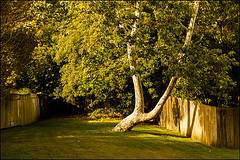If you have shady spots in your garden, then your lawn care strategy gets a little more complicated. Even the hardiest of grass needs some light to grow, but with a little extra effort you can still enjoy a high level of success.
The obvious way to overcome any lawn problems caused by too much shade is to remove the object that is causing the problem in the first place. However, there isn’t much you can do if the shade is being thrown by your house or your neighbours shed, in which case, read on for some tips on reviving a lawn that’s in need of some extra sun.

Photo by Brian J. Matis / CC BY
Re-seeding
You can’t use just any grass seed in a shady area. You’ll need to choose a mix that is tolerant to shady conditions. Mixes that include ‘fescue’ seed are often recommended as, although no grass will grow in total darkness, this hardy grass species does very well in dense shade.
Remove The Green Competition
If the shade is being caused by trees and it’s not possible to remove them, you should consider thinning the branches to let more light through. If you’re not experienced in this area then you should get in a professional tree surgeon to advise you.
Remember to give any grass that is under a tree a little extra water in warmer weather. The tree roots will be sucking up most of it from underneath, leaving your lawn thirsty. This is particularly important if you’ve taken the advice above and used a lawn seed mix that includes fescue, as this grass will tolerate shade but will suffer greatly if the soil is dry. However, do not waterlog the soil as this will encourage moss growth.
If your grass is getting less light, there may be wider gaps between plants caused by slowed growth. That could lead to increased moss growth as, although it normally grows slowly and therefore is no match for healthy grass, it can overtake a lawn that isn’t in peak condition. The first step is to remove the moss using lawn sand that is rich in ammonium sulphate to help the grasses heal after the harsh treatment. The next step is to tackle the causes of the moss, such as ensuring the soil is well-drained and not too compact.
Ongoing Care
Avoid unnecessary stress on the less hardy grass by treading on it as little as possible. This may mean slightly changing how you use your garden – for example, if you have a bench under the shade of a tree, you could move it to a shady patio area instead.
You should also be very careful when cutting your grass, and never take off more than 1/3 of the blade length. You also should, if possible, leave the blades in the shade a little longer than those that are in the full sun. This is to leave a bigger surface area to catch any of the precious light that does reach it, and allow photosynthesis to occur.
Re-Shape Your Garden
If the area is in full and solid shade then you may decide to change the usage of the area. Do some research into the various beautiful plants and flowers that are tolerant to dense shade. You can create either a flower bed or some pots and planters to fill the area. Alternatively, if you have a lot of time on your hands, you could look at the layout of your garden as a whole – is your shed in the sun when it could be in the shade? Can you move any storage and equipment into the shady spot? Grass that is planted in full shade is rarely successful, and never perfect, so it makes sense to concentrate your efforts on the lawn that is in full or partial sun.
All lawns, wherever they are placed, require a fair amount of tender loving care to keep them in top condition. Knowing which lawn care products to use and when can feel like a minefield, so to benefit from our experience, contact us at any time.























